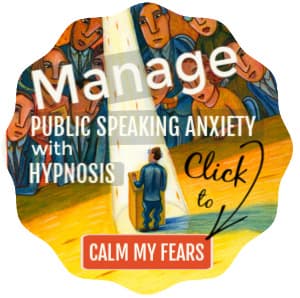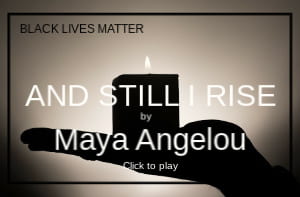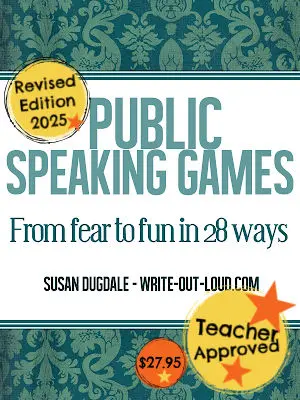How to memorize a speech easily
Here's how to memorize a speech using an acronym as a mnemonic or memory aid. It's a great method if you want to deliver your speech using minimal, or no notes.
This effective technique to memorize has been around a long, long time.
You'll more than likely already know it from your childhood. It was the way we remembered the seven colors of the rainbow, and their order, with the help of ROY-G-BIV: red, orange, yellow, green, blue, indigo and violet. Each letter represents a color. R = red, O = orange, and so on.
Now John Dean applies the same method in his article ...
How to memorize a speech using an acronym as a mnemonic
You can remember an entire speech using the letters of a keyword.
Here's an example from a speech I gave recently.
My speech title was : The significance of April 25th!
The acronym I used as a mnemonic was ANZAC.
(April 25th is ANZAC Day in Australia and New Zealand. It commemorates the soldiers of the Australian and New Zealand Army Corps who first fought side by side in World War One. The acronym ANZAC has been used ever since.)
Each letter served as a hook to remind me what I wanted to say in every section of my speech.
The examples I used are below. They may not make complete sense to you as most of the supporting material which would turn it from cryptic notes into a fully fledged speech has been left out but that does not matter. The acronym is not for the audience or you, the reader. It's for me and I'll flesh out the notes when I deliver the speech.
mnemonic And how do you say it? Find out from the: |
- A:Action – Gallipoli, Flanders, Torbrook, Kokoda ...
- N:Never - Australian blood never spilt on Australian soil, in a war situation
- Z:ZODIAC – “Down Under” the stars of the Southern Cross – emblazoned on our National flags
- A:Above Average – Sir Edmund Hillary, Jessica Watson ...
- C:Culture – The planet's best example of successful multi-cultural living
You can add to or, embellish your examples, depending on how long you have to speak. The only rule for using a word as an acronym is that it MUST make sense to you.
Using the 5W's and an H as a mnemonic
And here's another example of how to memorize a speech using the 5 W's and an H as a mnemonic.
(The 5 W's and an H, often called Rudyard Kipling's 6 honest serving men, is traditionally the journalist's formula for getting the full story.)
In our Toastmaster's Club, we have members who have never written a speech let alone delivered one.
When they ask, “How do I get started?” I give them this formula. It adapts to cover every type of story told and answers the question how to memorize a speech too.
- WHO?
If it is a human interest story, there is, a child, a youth or an adult involved - What?
If it is a physical story, there is, a before, an event and a result - When?
If it is a time frame, there is, yesterday, today and tomorrow - Where?
If it is a place, there is, before, during and after - Why?
If it is a question, there is, cause, effect and a remedy - How?
If it is a political, there is, local, state and federal
In addition every story always has a beginning, a middle and an end.
Now let's use this formula as an example of how to memorize a speech.
In this example the speech topic is the nursery rhyme Humpty Dumpty. The purpose of the speech is to explain the background of the nursery rhyme and how it came into being. The content of the speech is its story or time line.
Note: I gave this speech to my Toastmaster's Club to demonstrate the importance and use of variety in public speaking. It was 7 minutes long and I used the 5 W's and an H to memorize it.
Speech structure
Opening: recite the nursery rhyme
Humpty Dumpty sat on a wall,
Humpty Dumpty had a great fall.
All the king's horses and all the king's men
Couldn't put Humpty together again
Speech content: the story line using the 5 W's and an H as a mnemonic or memory aid
- WHEN:
About 1645 – in England – the reign of King Charles I - WHERE:
About 51 miles – north east out of London – along the A12 – at Colchester - WHAT:
During the English Civil war – an eleven week siege – at the church of Saint Mary’s - WHO:
Between the Royalists and the Parliamentarian forces - HOW:
The Royalists had taken the high ground at the site of St. Mary’s church and positioned a huge cannon on the tower wall. - WHY:
The position overlooked 360 degrees of the local area and was thought to be impregnable.
Result
This wall was of flimsy construction, the Parliamentarians blew a hole in it, the cannon fell to the ground, and disintegrated. And as the rhyme says, All the king's horses and all the king's men,
Couldn't put Humpty (the cannon or the wall) together again.
Speech Summary
This historical episode was recorded in the style of the time, in simple language, characterized into human form, and written as a nursery rhyme. War correspondents, photographs, live footage from the scene were not invented yet! The Murdock news empire came four centuries later!
Speech Conclusion
As the cannon was huge, it was named and portrayed as a huge egg – fragile in structure and material – once broken, could not be repaired.
This format or story telling still survives today. If I am to be interesting to listen to – there must be cadence in my voice. There must be variation in my pitch – if my story is to be remembered!
Without this variety – I’m a Humpty Dumpty.About John Dean
John is an experienced public speaker and member of the Cooroy Toastmasters Club Australia.
After he subscribed to the write-out-loud.com ezine Speaking Out Loud we began corresponding. He kindly offered an article on how to memorize a speech which I accepted with a grateful YES.
Here's what he says about himself:
I joined Australian Rostrum Club in 1950.
When I moved to Cooroy, there was no Rostrum club within a two hour drive. This year when Toastmasters established a club in Cooroy, I joined Toastmasters.
Earlier in my career, I ran Effective Speaking Courses for the Australian Institute of Management, in Brisbane. I did this for seventeen years teaching over 1400 students.
In 1987 I published a book “Effective Speaking – Here’s How!" - a tutorial text for high school students. In 1992 my book was revised and reprinted and although the Australian Federal Government still pays me an annual “lending Royalty”, it is out of print. In it I covered how to memorize a speech using of acronyms and mnemonics.
Pages of related interest to how to memorize a speech:
- how to prepare and use cue cards effectively
- how to rehearse a speech to lift it from ordinary to extraordinary
- how to use vocal variety to hold audience interest






